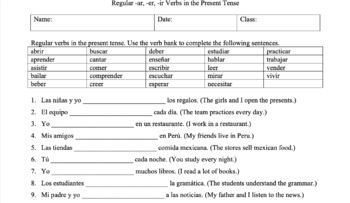- Sophia attends a lot of meetings.Nosotros recibimos un regalo. We also share information about your use of our site with our analytics partners who may combine it with other information that youve provided to them or that theyve collected from use of their services. Now that you know the pattern of a regular -ir verb, you could form the present tense of any other regular -ir verb: Vivo en esta ciudad. As a rule, cookies will make your browsing experience better. For example:Vivimos en una casa grande. If the infinitive of the Spanish verb ends in -ir, it means that the verb belongs to the third conjugation.
Note that because the verb endings show the person being referred to, it is most common to omit the subject pronouns. - You write a letter.Sofa asiste a muchas reuniones. - I live in this city.T escribes una carta. Here is the present tense of the regular -ir verb escribir: Here are some other regular -ir verbs:abrir - to openadmitir - to admitasistir - to assist, attenddescribir - to describedescubrir - to discoverdiscutir - to discusspermitir - to permitrecibir - to receivevivir - to live. - We receive a gift.Vosotras no abrs una ventana. Verbs with infinitives ending inir form a third group of regular verbs, often called third conjugation verbs. To conjugate -ir verbs in the present tense in Spanish, simply drop the -ir and add the following endings to the stem: -o, -es, -e, -imos, -s, -en. 2022, LanguagePosters.comPowered by Shopify, Spanish Preterite Tense Conjugation Chart.


 Ir appears on the 100 Most Used Spanish Verbs Poster as the 6th most used irregular verb. Send your comments and questions to the developers of this website. This site uses cookies small text files that are placed on your machine to help the site provide a better user experience. Which cookies and scripts are used and how they impact your visit is specified on the left.
Ir appears on the 100 Most Used Spanish Verbs Poster as the 6th most used irregular verb. Send your comments and questions to the developers of this website. This site uses cookies small text files that are placed on your machine to help the site provide a better user experience. Which cookies and scripts are used and how they impact your visit is specified on the left.
By using this site you are accepting the use of such cookies. - You (plural) don't open a window.Los campos de golf no cumplen estas condiciones.
The present continuous tense is formed by combining the auxiliary verb Estar with the gerundio.
Looking for more verbs like Ir? The following example show theirverbabrirconjugated in the present tense.
Below, comer (to eat), a common -er verb, and vivir (to live), a common -ir verb are divided by their stems (com-, viv-) and their conjugation endings, which change with the subject. In general, cookies are used to retain user preferences, store information for things like shopping carts, and provide anonymized tracking data to third party applications like Google Analytics. The gerundio of Ir is yendo. Learn and practice Spanish verbs conjugation with our free offline trainer. document.getElementById( "ak_js_1" ).setAttribute( "value", ( new Date() ).getTime() ); -ir verbs from the Spanish in Texas Corpus. COERLL The University of Texas at Austin [emailprotected]. By using this form you agree with the storage and handling of your data by this website. Click here to leave a review. Nosotros comemos a las cinco.Ellos viven en Espaa. It is possible to prevent cookies from being used in your browser by turning the feature off, but in order to make your experience better, your browser must be set to accept cookies. - We live in a big house. A verb is called a regular verb when its conjugation follows a typical pattern. Check out our Spanish Conjugation Chart, the 100 Most Used Spanish Verbs Poster!
In Spanish, the 3 regular patterns are for verbs ending in ar, er, and ir.
The most effective way to do this is to disable cookies in your browser. NOTE: These settings will only apply to the browser and device you are currently using. The present perfect tense is formed by combining the auxiliary verb haber with the participio. You may change your settings at any time.
Cookies are alphanumeric identifiers that we transfer to your computers hard drive through your web browser. In English, the infinitive form of a verb is typically indicated with "to". Comparisons and Superlatives with Adjectives. Thank you for your purchase! To form the present tense conjugations of these verbs, drop their from the infinitive and add the third conjugation endings (-o,-es,-e,-imos, -en) to the resulting stem. vosotros comisvosotros vivs. Atention:Like all -er and -ir verbs, vivir and comer conjugations differ from each other in the nosotros and vosotros forms. A verb which does not follow these patterns exactly is called an irregular verb. The participio of Ir is ido. However, you may prefer to disable cookies on this site and on others. Ir is a Spanish irregular verb meaning to go. We suggest consulting the Help section of your browser or taking a look at the About Cookies website which offers guidance for all modern browsers. We use cookies to analyze our website traffic.
For example: escribir ("to write"), in which escrib- is the stem and -ir is the infinitive ending.
nosotros comemosnosotros vivimos Conjugating regular verbs is a snap. For the preterite tense conjugation, go to Ir Preterite Tense Conjugation.
Your choices will not impact your visit. A reference grammar with video examples from the Spanish in Texas collection. We use cookies and external scripts to enhance your experience. For example: "to live or to receive. In Spanish, verbs have a stem (or root) and an infinitive ending.
ER and IR verb conjugations in the present tense are almost identical. Once you have learned the pattern of regular verbs you can confidently use any regular verbs in the same way.
Verbs that don't change their stem are called regular verbs.
They make it possible for us to store your navigation habits, recognize your browser when you visit. - Golf courses do not meet these conditions. All regular -er and -ir verbs are conjugated in this way, by adding the ending on to the stem. Notice that l, ella, and usted share the same verb form in the singular, and ellos, ellas, and ustedes share the same verb form in the plural.